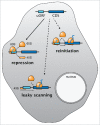Decoding sORF translation - from small proteins to gene regulation
- PMID: 27653973
- PMCID: PMC5100344
- DOI: 10.1080/15476286.2016.1218589
Decoding sORF translation - from small proteins to gene regulation
Abstract
Translation is best known as the fundamental mechanism by which the ribosome converts a sequence of nucleotides into a string of amino acids. Extensive research over many years has elucidated the key principles of translation, and the majority of translated regions were thought to be known. The recent discovery of wide-spread translation outside of annotated protein-coding open reading frames (ORFs) came therefore as a surprise, raising the intriguing possibility that these newly discovered translated regions might have unrecognized protein-coding or gene-regulatory functions. Here, we highlight recent findings that provide evidence that some of these newly discovered translated short ORFs (sORFs) encode functional, previously missed small proteins, while others have regulatory roles. Based on known examples we will also speculate about putative additional roles and the potentially much wider impact that these translated regions might have on cellular homeostasis and gene regulation.
Keywords: Ribosome; sORF; short proteins; translation; translational regulation; uORF.
Figures


Similar articles
-
Global analysis of ribosome-associated noncoding RNAs unveils new modes of translational regulation.Proc Natl Acad Sci U S A. 2017 Nov 14;114(46):E10018-E10027. doi: 10.1073/pnas.1708433114. Epub 2017 Oct 30. Proc Natl Acad Sci U S A. 2017. PMID: 29087317 Free PMC article.
-
Translation of Small Open Reading Frames: Roles in Regulation and Evolutionary Innovation.Trends Genet. 2019 Mar;35(3):186-198. doi: 10.1016/j.tig.2018.12.003. Epub 2018 Dec 31. Trends Genet. 2019. PMID: 30606460 Review.
-
Ribosome profiling reveals the rhythmic liver translatome and circadian clock regulation by upstream open reading frames.Genome Res. 2015 Dec;25(12):1848-59. doi: 10.1101/gr.195404.115. Epub 2015 Oct 20. Genome Res. 2015. PMID: 26486724 Free PMC article.
-
Deciphering poxvirus gene expression by RNA sequencing and ribosome profiling.J Virol. 2015 Jul;89(13):6874-86. doi: 10.1128/JVI.00528-15. Epub 2015 Apr 22. J Virol. 2015. PMID: 25903347 Free PMC article.
-
Evolution of new proteins from translated sORFs in long non-coding RNAs.Exp Cell Res. 2020 Jun 1;391(1):111940. doi: 10.1016/j.yexcr.2020.111940. Epub 2020 Mar 7. Exp Cell Res. 2020. PMID: 32156600 Review.
Cited by
-
Exposing the small protein load of bacterial life.FEMS Microbiol Rev. 2023 Nov 1;47(6):fuad063. doi: 10.1093/femsre/fuad063. FEMS Microbiol Rev. 2023. PMID: 38012116 Free PMC article. Review.
-
A helicase links upstream ORFs and RNA structure.Curr Genet. 2019 Apr;65(2):453-456. doi: 10.1007/s00294-018-0911-z. Epub 2018 Nov 27. Curr Genet. 2019. PMID: 30483885 Free PMC article. Review.
-
NR2C2-uORF targeting UCA1-miR-627-5p-NR2C2 feedback loop to regulate the malignant behaviors of glioma cells.Cell Death Dis. 2018 Dec 5;9(12):1165. doi: 10.1038/s41419-018-1149-x. Cell Death Dis. 2018. PMID: 30518750 Free PMC article.
-
The cancer-associated microprotein CASIMO1 controls cell proliferation and interacts with squalene epoxidase modulating lipid droplet formation.Oncogene. 2018 Aug;37(34):4750-4768. doi: 10.1038/s41388-018-0281-5. Epub 2018 May 16. Oncogene. 2018. PMID: 29765154
-
Revealing the small proteome of Haloferax volcanii by combining ribosome profiling and small-protein optimized mass spectrometry.Microlife. 2023 Jan 16;4:uqad001. doi: 10.1093/femsml/uqad001. eCollection 2023. Microlife. 2023. PMID: 37223747 Free PMC article.
References
-
- Guttman M, Rinn JL. Modular regulatory principles of large non-coding RNAs. Nature 2012; 482:339–46; PMID:22337053; http://dx.doi.org/10.1038/nature10887 - DOI - PMC - PubMed
-
- Lin MF, Jungreis I, Kellis M. PhyloCSF: a comparative genomics method to distinguish protein coding and non-coding regions. Bioinformatics 2011; 27:i275-82; PMID:21685081; http://dx.doi.org/10.1093/bioinformatics/btr209 - DOI - PMC - PubMed
-
- Ingolia NT, Ghaemmaghami S, Newnam JRS, Weissman JS. Genome-wide analysis in vivo of translation with nucleotide resolution using ribosome profiling. Science 2009; 324:218–23; PMID:19213877; http://dx.doi.org/10.1126/science.1168978 - DOI - PMC - PubMed
-
- Ingolia NT, Lareau LF, Weissman JS. Ribosome Profiling of Mouse Embryonic Stem Cells Reveals the Complexity and Dynamics of Mammalian Proteomes. Cell 2011; 147(4):1–23; PMID:22056041; http://dx.doi.org/2701530510.1016/j.cell.2011.10.002 - DOI - PMC - PubMed
-
- Ingolia NT. Ribosome Footprint Profiling of Translation throughout the Genome. Cell 2016; 165:22–33; PMID:27015305; http://dx.doi.org/10.1016/j.cell.2016.02.066 - DOI - PMC - PubMed
Publication types
MeSH terms
Substances
LinkOut - more resources
Full Text Sources
Other Literature Sources
